Projects rarely comprise a few simple tasks on a checklist. They usually involve a long list of complex tasks and subtasks that depend on specific milestones. Listing out those tasks is one thing, but managing them in the correct sequence so your project runs like clockwork is another.
Project management software can help teams define, visualize, and manage task dependencies so that tasks start and finish based on logical relationships and prerequisites, without any guesswork or overlooked details. In this guide, we’ll cover everything you need to know about task dependencies and show you how monday work management uses AI and automations to simplify task dependency management.
Get startedWhat are task dependencies in project management?
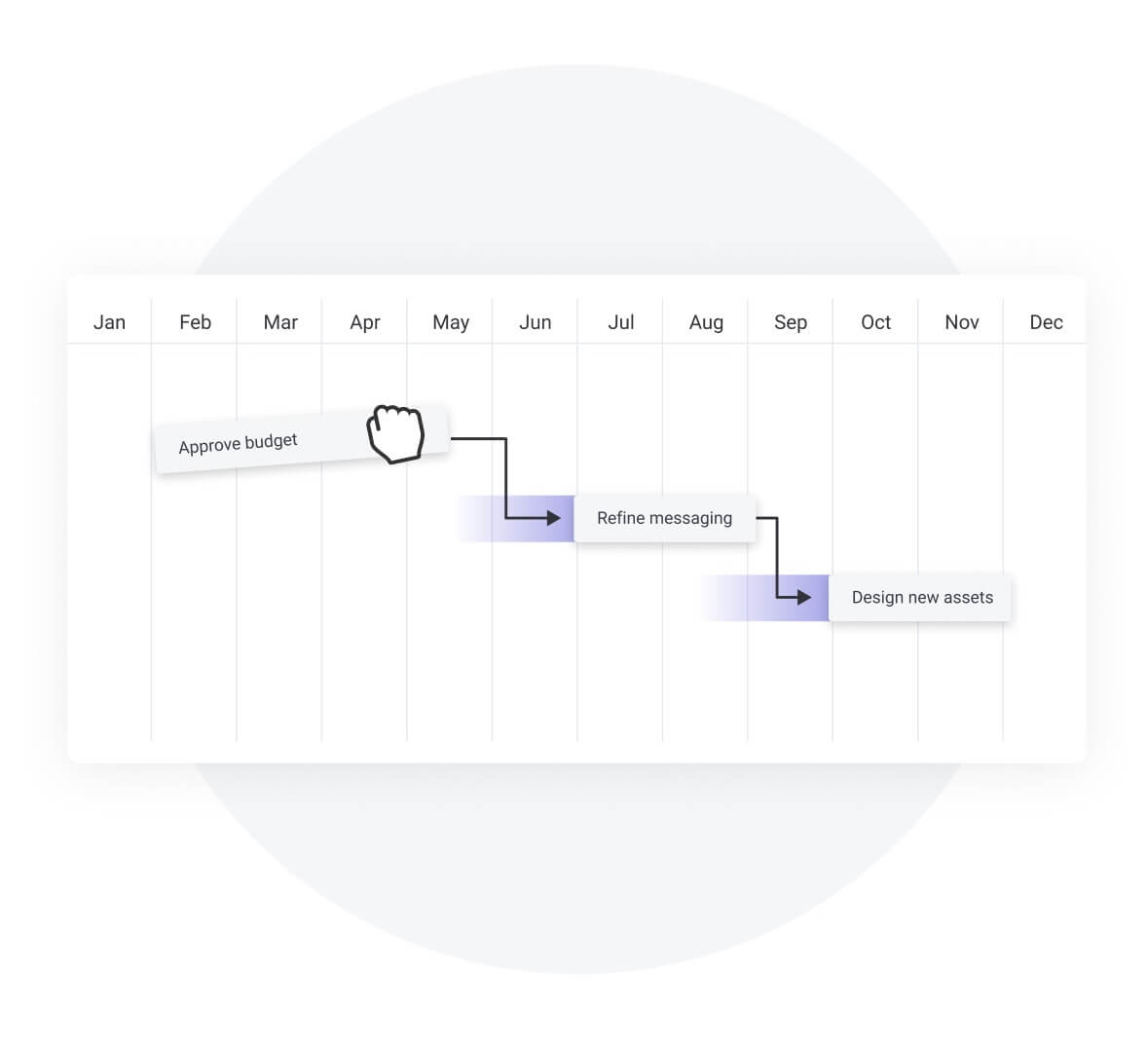
Task dependencies refer to the relationships between tasks based on their sequence. A dependent task requires one or more other tasks to be completed or started before work can begin.
Identifying and handling dependencies is considered one of the most critical and consequential tasks in project management, as it ensures teams complete work correctly and efficiently. Think of it as constructing an apartment building. You can’t start building out each unit without first laying the foundation, and you can’t install kitchen cabinets before the walls and plumbing are in place.
Similarly, in project management, a software team can’t begin quality assurance testing until developers finish coding the feature. A product launch can’t proceed until marketing materials are approved and inventory is secured. When project managers map out these dependencies early, they can create realistic timelines, allocate resources effectively, and identify potential risks before they derail the project.
Key terms to know when looking at task dependencies
Before going deeper into project task dependencies, it’s important to have a good grasp of the terminology frequently used in projects. Here are a few key terms to be aware of.
Critical path
In project management, your critical path is the longest sequence of dependent tasks that need to be completed in order to finish a project. If we go back to our example of constructing an apartment building, the critical path might look like this: obtain permits → excavate site → pour foundation → frame structure → install roof → complete exterior walls → finish interior systems.
The critical path method is essential to running a project, since when you understand which tasks are on the critical path, it’s easier to prioritize and avoid harmful delays. Tasks not on the critical path have some flexibility or “float time,” meaning they can be delayed slightly without affecting the project’s overall deadline.
Blockers
Anything that puts an obstacle between your team and completing your project is a blocker. In practice, a blocker can be issues like team members calling in sick, waiting for client approvals, technical issues like server outages, or late vendor deliveries. Being aware of potential blockers early on can help you plan for risk and keep your delivery timeline on track.
Project constraints
Your project constraints provide the framework for your overall project and each task. Most often, these constraints include core aspects of running a project, like costs, timeline, and scope. These 3 elements need to be clearly defined and balanced so that tasks don’t force a project to run late, go over budget, or grow in scope.
Why task dependencies matter in project management
Dependencies serve as a project’s logical framework, ensuring work happens in the right sequence with optimal resource utilization. They allow for realistic scheduling that accounts for how work actually progresses. Without proper dependency management, a project risks becoming a collection of disconnected tasks. Here are some reasons why task dependencies are important for successful project management.
Timeline accuracy
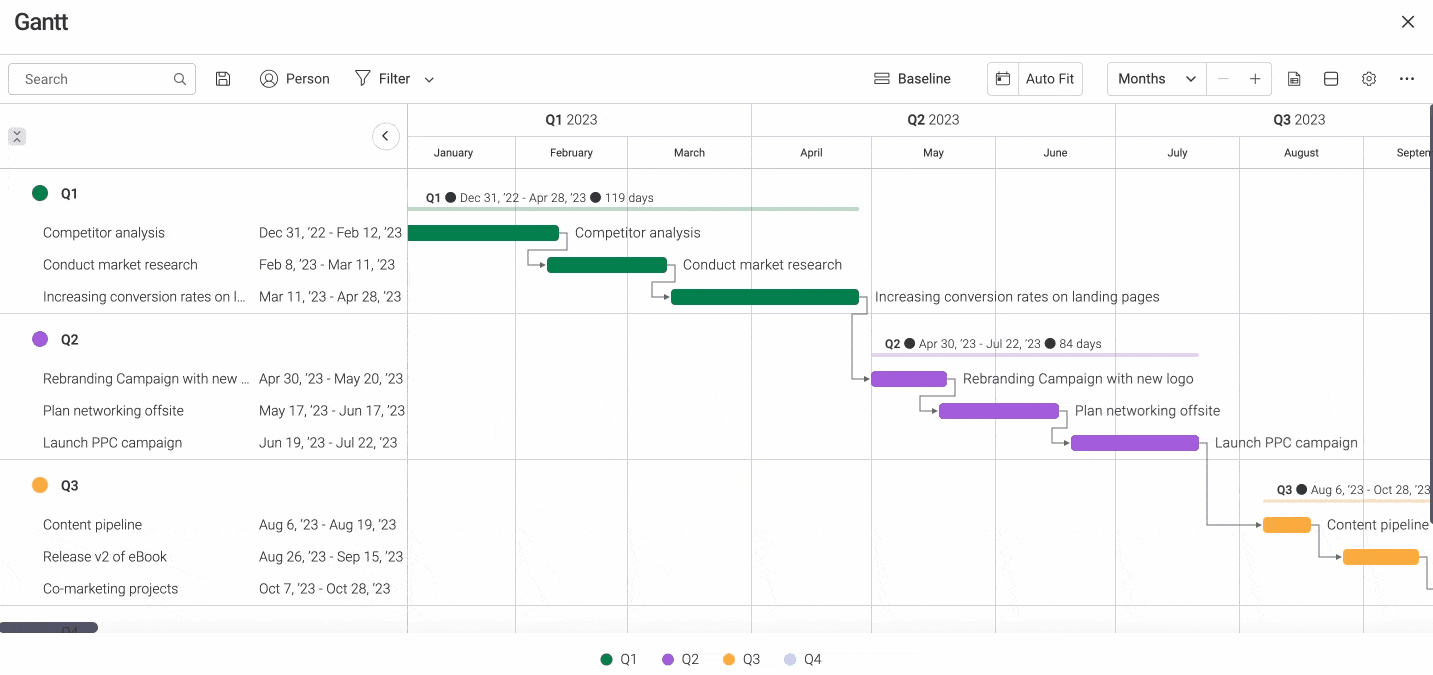
Dependencies make schedules realistic because they force the “what has to happen first” logic into your plan. When you map them early, you can spot fragile handoffs, see which delays will cascade, and set expectations with stakeholders before dates become commitments.
Resource optimization
Once you know what tasks must be completed and their estimated duration, allocating resources is much simpler. Using an integrated platform like monday work management, you can easily create alignment between resource tracking and your project schedule. For example, you can set up an automated email to contractors to confirm availability before work is due to start.
Risk mitigation
External dependencies add significant risk to a project schedule, resulting in unexpected bottlenecks, timeline disruptions, and resource challenges. Flag external dependencies using a project risk register so that business stakeholders are aware of potential impact well in advance and can create an appropriate contingency plan. With software like monday work management, you can visually organize, plan, and track every project task dependency in a few clicks.
The 4 types of time-based task dependencies in project management
Projects can have dozens of dependencies, and the relationship between tasks can vary according to the project phase. Here are the 4 most common types of time-based task dependencies in project management, along with when each one is typically used and a simple example:
| Dependency type | What it means | When it’s used | Simple example |
|---|---|---|---|
| Finish to start (FS) | Task B can’t begin until Task A is completed | Sequential work where one task fully depends on the output of another | Development must finish before QA testing begins |
| Start to start (SS) | Task B can begin once Task A starts | Parallel work that needs coordination | Testing begins once development starts |
| Finish to finish (FF) | Task B can’t be completed until Task A is completed | Tasks that must finish together | Final documentation completes when development completes |
| Start to finish (SF) | Task B can’t be completed until Task A starts | Handoffs requiring continuous coverage | Night shift can’t end until day shift starts |
Other types of dependencies in project management
Aside from the 4 time and relationship-based task dependencies we covered above, there are other ways tasks can be dependent on each other in a project, particularly when it comes to managing dependencies across teams and departments. Let’s break down some additional types of task dependencies common in project management.
- Logical dependencies: Also referred to as causal dependencies, these refer to logical sequential tasks; for example, you need foundations laid before bricklaying commences.
- Resource dependencies: When project tasks need similar resources, such as the same team member, equipment, or software, that isn’t available until another task is completed.
- Preferential dependencies: Sometimes called discretionary dependencies, these are sequences based on the preferences of stakeholders or team members, where one task is prioritized over another based on best practices or previous experience.
- Cross-team dependencies: When one team or department is waiting on another team’s work to complete a task, such as a sales team waiting for R&D to complete a product feature before offering it to customers.
- External dependencies: Tasks dependent on external factors outside the control of a project team, such as weather events, bureaucracy, or legislature.
Task dependencies vs. project dependencies: What’s the difference?
Earlier, we saw the 4 main types of task dependencies. Think of these dependencies as the format that dictates a project’s timeline, whereas project dependencies are a little broader and refer to how tasks link together throughout a project.
In other words, task dependencies are relationships between individual tasks inside a project, and project dependencies are dependencies between projects/phases/programs at a portfolio level.
The table below breaks down the differences between the 2 in a little more detail:
| Aspect | Task dependencies | Project dependencies |
|---|---|---|
| Scope | Relationships between specific tasks (finish-to-start, start-to-start, etc.) | How tasks and deliverables link together across a project or between projects |
| Granularity | Task-to-task level | Project-to-project or phase-to-phase level |
| Example | Design must be approved before development begins | Mobile app launch depends on completion of API infrastructure project |
| Impact | Day-to-day workflow and task sequencing | Cross-project delivery and strategic milestones |
| Management | Project managers and team leads | Portfolio managers and executives |
| Visibility | Team boards and project schedules | Portfolio dashboards and roadmaps |
How to identify task dependencies in your project
Identifying dependencies requires a lot of analytical thinking and practical project knowledge. It’s often a long process that requires getting into the small details of each task. The good news is that once you do it enough times, you can learn from the process and replicate it to make it quicker. If you’re just starting out, here are 4 steps you’ll want to follow.
Step 1: List all project tasks
To begin, you need to review your project’s scope and objectives to understand all the tasks that need to be completed and in which sequence. Consider using a work breakdown structure (WBS) to systematically identify tasks such as major deliverables.
Once you have all your project tasks listed, you want to estimate how many hours each will take and map out related resources. This will help you pinpoint the high-priority tasks that may have more dependencies. Make sure to get different team members involved in this process so that nothing gets overlooked.
Step 2: Map task relationships
After listing and prioritizing your project tasks, you want to start mapping their relationships. This part can be time-consuming, but it’s essential to successful project management. You want to examine each task and ask what needs to happen before it starts and what relies on its completion.
Work through tasks chronologically, by resource needs, or department to make it easier to determine cross-functional relationships. The key here is being thorough and consistent so that you cover all your bases and minimize downtime and risks.
Step 3: Classify dependency types
Once you’ve mapped out your task relationships, it’s time to assign a dependency type. This will help you further prioritize different tasks and place them in a sequence that makes sense. It’s not uncommon that most of your tasks will be finish-to-start, but look out for the other 3 types so that you understand what work can be done in parallel or needs to follow a sequence.
Step 4: Validate with your team
Finally, once all your tasks are listed, relationships are clear, and they’re tagged by dependency type, have your entire team look it over to try and spot any holes. A dependency review will allow you to get ahead of potential delays by seeing where handoffs between teams may be required. Additionally, gathering input will help you assess whether the dependency roadmap is actually realistic based on how your team works.
The process of identifying task dependencies can be done manually, though you may be opening the door to mistakes. It’s a good idea to conduct this procedure using project management software to create a visual representation of the project schedule and automate specific processes like handoffs, deadline reminders, and risk management.
Get startedAutomating task dependencies to streamline project management
While managing task dependencies can be a lot of work, much of the manual tracking can be automated with smart project management systems and artificial intelligence. That said, automation won’t completely eliminate the need for human oversight, but it will reduce the amount of manual work required so that teams can focus on more complex tasks.
Project management software with AI and automation capabilities can help teams streamline efforts in a few core ways:
- AI can help teams surface risk signals and prioritize follow-ups
- Automated dependency workflows make it quick and easy to handle repetitive dependency management tasks
- Dynamic dependency tracking can continuously monitor statuses and adjust project plans as needed
- Advanced AI reporting can give teams insights into potential bottlenecks, critical path risks, and resource allocation issues before they impact delivery timelines
- Intelligent notifications and alerts can proactively warn teams when tasks are delayed or at risk, allowing them to adjust and prevent delays across the project
Optimize task dependencies with monday work management
The first step to managing task dependencies is choosing a software solution that will make your work easier. With monday work management, you get a platform backed by powerful AI that comes built with the tools you need to track, manage, and automate dependencies.
Thanks to monday work management’s visual interface and different work views, it’s easy to trace the sequence of tasks with drag-and-drop boards. The platform gives you the ability to shift project tasks around while maintaining connections between dependent tasks, creating fantastic flexibility throughout a project.
Here’s a look at some of the features built into monday work management that make it an excellent choice for tracking task dependencies.
Comprehensive dependency visualization
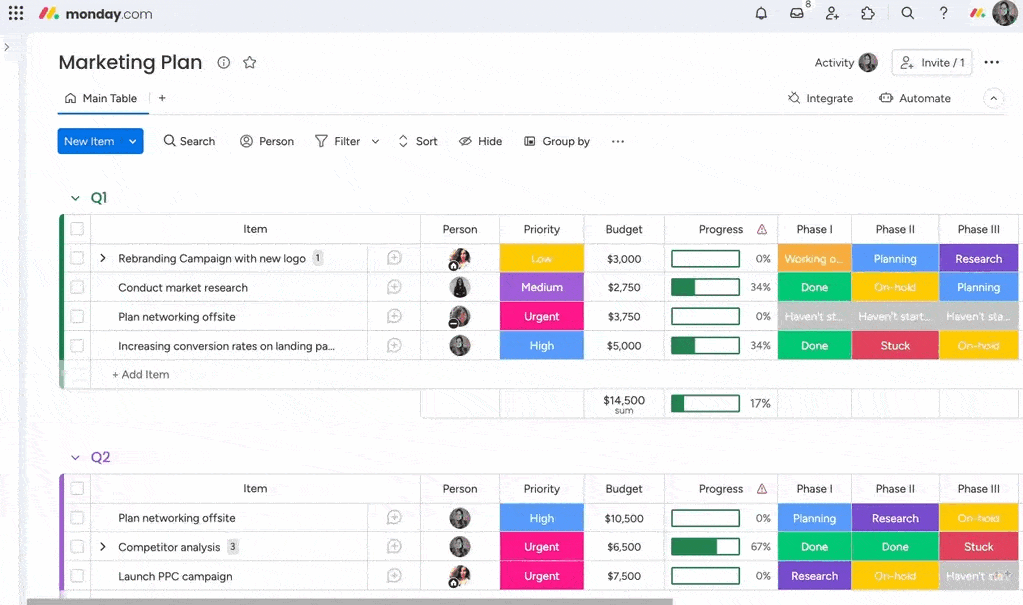
In monday work management, you can use the Dependency Column to define dependency relationships between items on your board. Choose the mode in which your dependencies will work — Flexible, Strict, or No action — and then add a Time Column to anchor tasks to deadlines.
No-code dependency automations
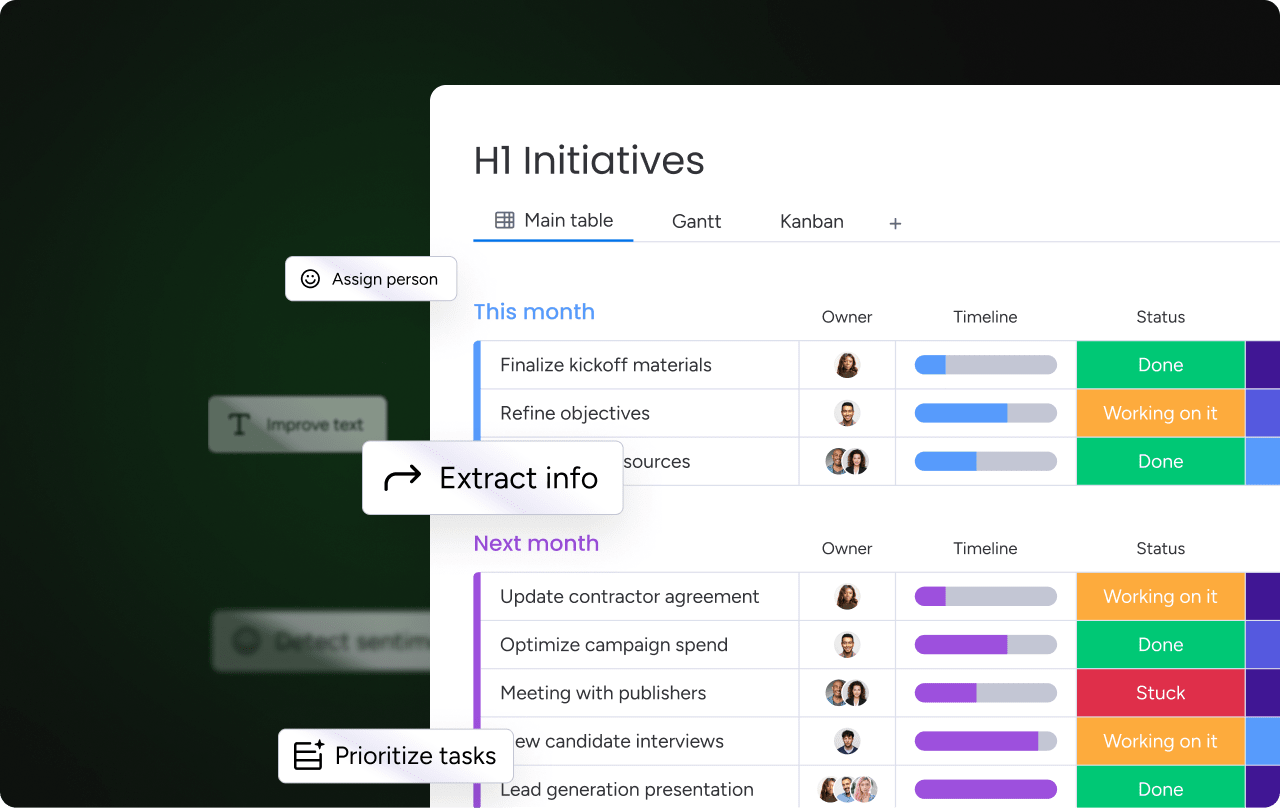
Set up smart automations that use AI to trigger actions based on predetermined parameters. For example, in monday work management, you can set up an automation to send notifications when dependency delays threaten deadlines so you’re always one step ahead. Additionally, using AI blocks, teams can instantly categorize tasks based on dependencies for quick prioritization.
Real-time dependency monitoring and alerts
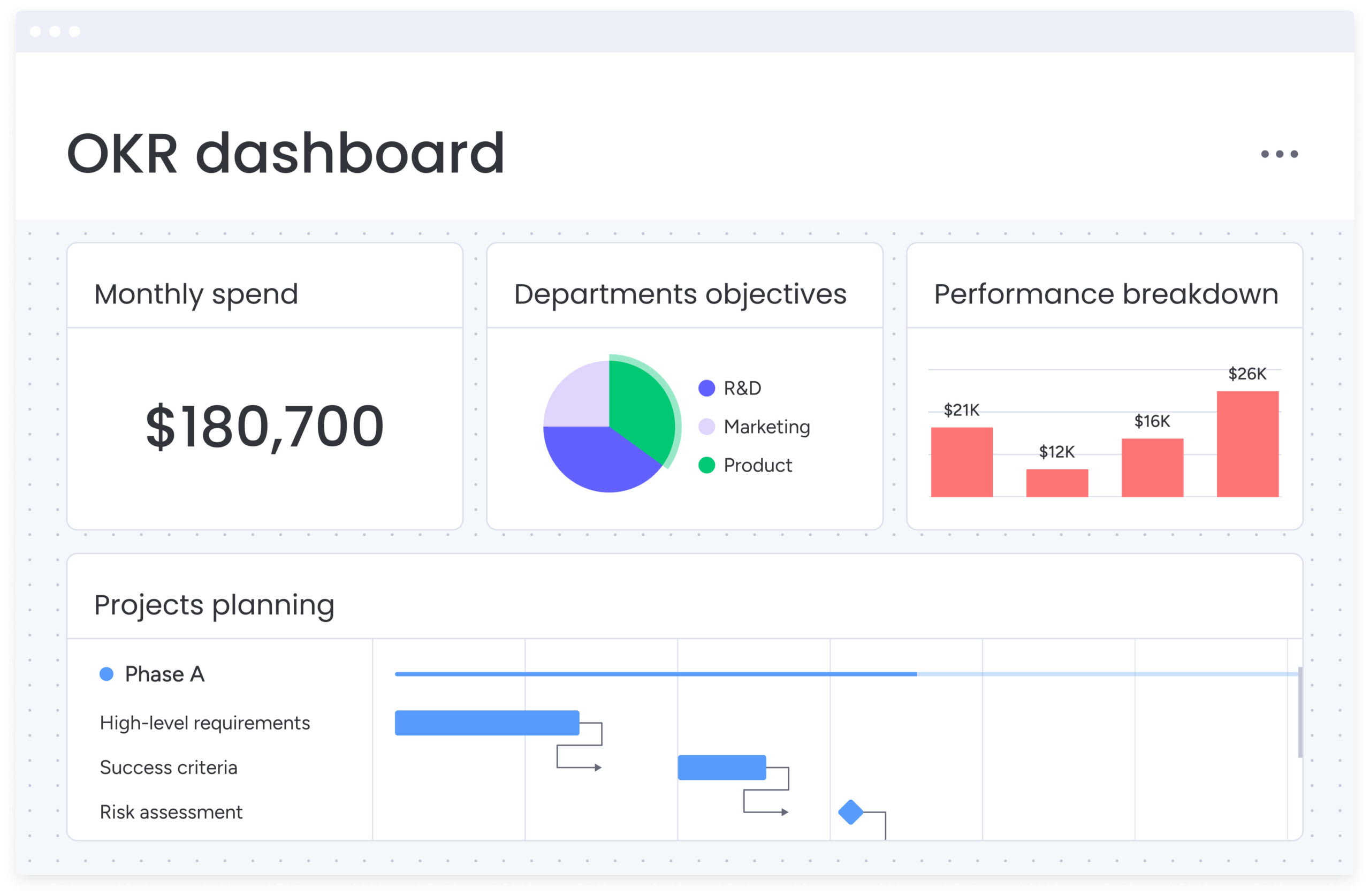
With built-in reporting and data analytics capabilities backed by AI, monday work management makes it easy for teams to trace exactly where risk can occur. Teams can also use project dashboards to measure progress, and use project dashboards and reporting to spot bottlenecks early based on historical patterns of previous dependencies.
Cross-team collaboration tools

All your teams can get on board with one unified platform and stay on top of critical task alerts and essential communications. Cross-board automations make it easy to connect dependencies to items on other departments’ boards and trigger actions based on changes. Additionally, shared dashboards give all stakeholders visibility into project status, and communication features keep everyone informed of updates.
Best practices for enhancing task and project dependencies
Aside from identifying dependencies and categorizing them by type, there are a few more tips you can put into practice to improve how your team manages dependencies:
- Visualize dependencies: Use project management software to visualize task dependencies and create a map or visual representation of the project schedule. You can use different approaches here, such as a network diagram, Gantt charts, flowcharts, or others.
- Reduce the number of dependencies: Where possible, reduce the number of dependencies by simplifying the project scope, breaking down tasks into smaller components, and eliminating unnecessary tasks.
- Communicate with stakeholders: Establish clear communication channels among team members to ensure everyone knows the dependencies and their impact on the project.
- Set up dependency alerts: Get notified of dependency-related delays such as resource conflicts, milestone risks, or external dependency statuses with AI-powered software and automations.
- Monitor dependencies in real time: Make sure to stay aware of each status with dashboard views, status tracking, forecasting, and reports so that you’re not blindsided by delays or shifting project needs.
- Create dependency templates: Many projects will follow a similar pattern, so create templates that make it easy to start based on project type, processes, or industry.
Master projects with a top-notch task dependency management platform
Managing task dependencies is one of the most crucial and consequential activities in project management, as it ensures projects are completed on time and within budget. With monday work management — built upon the robust monday.com Work OS — you can visually organize, plan, and track every project task dependency in a few clicks.
Get startedTask Dependencies
What are the most common project dependencies examples?
The most common project dependencies include approval processes where budget approval must occur before spending, sequential work phases where design must be completed before development, resource handoffs where one team must finish before another begins, and external deliveries where vendor materials must arrive before assembly can start.
Can a task have multiple dependencies?
Of course. Project tasks often have multiple dependencies, such as waiting for both design approval and resource availability before starting, or requiring completion of several prerequisite tasks before beginning the next project phase.
What's the difference between mandatory and discretionary dependencies?
Mandatory dependencies are required by the nature of the work, while discretionary dependencies are chosen for efficiency or preference. For example, when developing software, you need to write code before you can test it, but choosing to complete the user interface design before starting backend development is a discretionary dependency. While it might be more efficient to work this way, it's not technically required, and both could happen in parallel.
How does monday work management handle complex dependency chains?
Thanks to its Gantt chart and timeline features, monday work management automatically calculates dependencies, providing visual mapping of complex relationships while using AI-powered insights to identify potential bottlenecks and suggest optimization opportunities across multiple connected projects.
What happens when a dependency is broken or delayed?
When dependencies are delayed, all subsequent tasks in the chain must shift their start dates accordingly, potentially affecting the entire project timeline and impacting budgets, resources, and deliverables. Modern platforms like monday work management provide automated alerts and schedule adjustments to minimize impact and enable proactive response.
